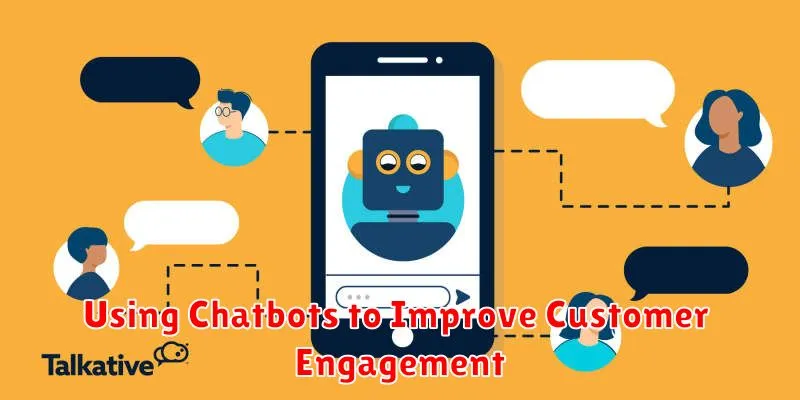In today’s rapidly evolving digital landscape, customer engagement is paramount to the success of any business. Organizations are constantly seeking innovative ways to connect with their customers, provide seamless experiences, and foster lasting relationships. Chatbots have emerged as a powerful tool for achieving these goals, offering a transformative approach to customer service, marketing, and overall customer experience. This article explores the multifaceted ways in which chatbots can be leveraged to significantly improve customer engagement, driving business growth and enhancing customer satisfaction.
From providing instant support and personalized recommendations to streamlining processes and gathering valuable customer insights, chatbots offer a wealth of opportunities for businesses to enhance customer engagement. By automating routine tasks, chatbots free up human agents to focus on more complex issues, ultimately leading to improved efficiency and a more personalized experience for the customer. This article will delve into the specific benefits of using chatbots, providing practical examples and actionable strategies for implementing them effectively to maximize customer engagement and achieve tangible business results.
What Are Chatbots?
Chatbots are software applications designed to simulate human conversation. They employ artificial intelligence (AI) and natural language processing (NLP) to understand user queries and provide relevant responses. These interactions can occur through various channels, including websites, mobile apps, and messaging platforms.
Key characteristics of chatbots include their ability to automate repetitive tasks, offer 24/7 availability, and provide personalized experiences. They are increasingly used by businesses to improve customer service, streamline operations, and enhance overall engagement.
Types of Chatbots for Businesses
Businesses can leverage various chatbot types to enhance customer engagement. These can be broadly categorized based on their underlying technology and capabilities.
Rule-based chatbots follow pre-defined rules and scripts. They are effective for answering simple, frequently asked questions but lack the flexibility to handle complex inquiries.
AI-powered chatbots utilize machine learning and natural language processing (NLP) to understand and respond to user input more conversationally. They can handle more complex interactions and learn from user data to improve their performance over time. Within this category are retrieval-based and generative AI chatbots. Retrieval-based chatbots select responses from a predefined database, while generative chatbots create responses from scratch.
Benefits of Chatbots in Customer Service

Chatbots offer numerous advantages for businesses seeking to enhance their customer service. A primary benefit is 24/7 availability, enabling customers to receive support at any time, regardless of business hours. This leads to increased customer satisfaction and potentially higher conversion rates.
Cost savings are another significant advantage. By automating routine inquiries, chatbots reduce the need for large human support teams, freeing up human agents to handle more complex issues. This streamlined approach optimizes resource allocation and lowers operational expenses.
Furthermore, chatbots provide consistent service quality. They deliver pre-programmed responses, ensuring every customer receives the same level of service and information. This consistency contributes to a professional brand image and builds customer trust.
Implementing a Chatbot Strategy
Implementing a successful chatbot strategy requires careful planning and execution. It begins with identifying key objectives. What do you want your chatbot to achieve? Common goals include improving customer service, generating leads, or streamlining internal processes.
Next, define your target audience. Understanding their needs and preferences will inform the chatbot’s design and conversational flow. Consider the platforms your audience uses and integrate the chatbot accordingly.
Finally, continuous monitoring and optimization are essential. Analyze chatbot interactions, gather user feedback, and make adjustments to improve performance and ensure alignment with your objectives.
Cost and ROI of Chatbots
Implementing chatbots involves varying costs depending on complexity and functionality. Simple rule-based chatbots can be relatively inexpensive, while AI-powered chatbots with advanced natural language processing (NLP) capabilities require a larger investment.
Calculating ROI involves considering factors like reduced customer service costs, increased sales conversions, and improved customer satisfaction. Cost savings are achieved through automation of routine inquiries, freeing up human agents. Increased sales can result from personalized recommendations and 24/7 availability. Improved customer satisfaction stems from faster response times and convenient self-service options.
While initial costs can vary, chatbots often offer a strong ROI by streamlining operations and enhancing customer engagement.
Common Mistakes to Avoid
While chatbots offer immense potential for enhancing customer engagement, deploying them without a clear strategy can lead to negative experiences. Avoid these common pitfalls for a successful implementation.
Over-Reliance on Automation
Failing to provide a seamless transition to human agents when necessary can frustrate customers. Ensure your chatbot can escalate complex issues efficiently.
Lack of Personalization
Generic responses feel impersonal. Tailor your chatbot’s interactions based on customer data and past interactions to provide a more engaging experience.
Ignoring Analytics
Regularly monitor chatbot performance metrics. Analyze conversation logs and identify areas for improvement to optimize its effectiveness and address customer pain points.
Integration with CRM and Other Tools
Integrating your chatbot with your CRM (Customer Relationship Management) system is crucial for maximizing its effectiveness. This integration allows the chatbot to access customer data, providing personalized interactions and more efficient service. For example, a chatbot can greet a returning customer by name and offer tailored recommendations based on past purchases.
Beyond CRM, chatbots can integrate with various other tools, such as marketing automation platforms, help desk software, and e-commerce systems. This creates a seamless customer experience across multiple touchpoints. By connecting these systems, businesses can gather valuable data and insights into customer behavior, leading to improved marketing campaigns and more targeted customer support.
Privacy and Security Considerations
When integrating chatbots, prioritizing user privacy and data security is paramount. Data breaches and misuse of personal information can severely damage reputation and erode customer trust.
Chatbots often handle sensitive data, including personally identifiable information (PII). Implementing robust security measures, such as encryption and access controls, is crucial to protecting this information. Regular security audits and vulnerability assessments are also necessary to identify and address potential weaknesses.
Compliance with data privacy regulations, such as GDPR and CCPA, is mandatory. This includes obtaining explicit consent for data collection and usage, providing transparency about data handling practices, and enabling users to access, modify, and delete their data.
Analyzing Chatbot Performance
Analyzing chatbot performance is crucial for maximizing its effectiveness and ensuring it meets your business objectives. Key Performance Indicators (KPIs) provide quantifiable measurements to assess chatbot success.
Some important KPIs include: completion rate (percentage of conversations completed successfully), customer satisfaction (CSAT) score (gauging user happiness), first response time (how quickly the chatbot responds to initial inquiries), fall-back rate (frequency of human agent intervention), and intent recognition rate (accuracy of the chatbot in understanding user requests).
Regular monitoring of these KPIs allows you to identify areas for improvement, optimize chatbot conversations, and ultimately enhance customer engagement.
Future of Chatbots in Business

The future of chatbots in business is bright, promising enhanced customer experiences and streamlined operations. Advancements in artificial intelligence and natural language processing will enable chatbots to handle increasingly complex interactions, moving beyond simple queries to provide personalized recommendations and proactive support.
Integration with other business systems will become more seamless, allowing chatbots to access and utilize customer data to deliver highly tailored solutions. This will lead to improved customer satisfaction and increased efficiency.
Voice-activated chatbots are expected to grow in popularity, offering a more natural and convenient way for customers to interact with businesses. Furthermore, chatbots will play a key role in automating various business processes, from lead generation to customer service, freeing up human agents to focus on more strategic tasks.

